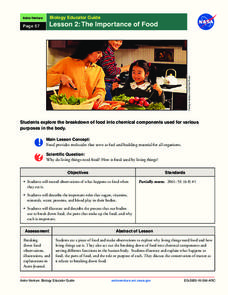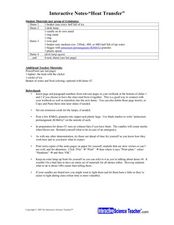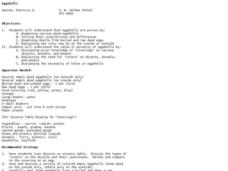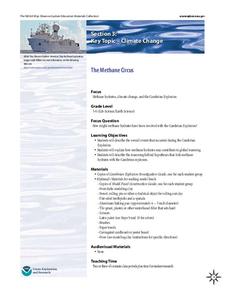Baylor College
Moving Air
In lab groups, young scientists place aluminum cans with a bubble-solution cap into different temperatures of water to see what size of bubble dome forms. As part of an atmosphere unit in preparation for learning about convection...
Curated OER
Polymers-Greaaaaaat Biiiiiig Molecuuuuuules
Students explore polymer properties. In this lesson about polymers, students perform an experiment to understand polymers, their properties, and that they are formed from small molecules. Students role play pretending they are polymer...
Curated OER
Bubbleology Mickey Mouse Style
Students investigate the effects of four different shaped wands and geometric shapes in a bubble solution. In this bubbleology lesson plan, the students build water and soap molecules. Students work in cooperative groups and conduct...
Curated OER
Make Slime
Students make slime. In this chemical reaction lesson plan, student use Borax to make a gel like solution. Students add all ingredients listed, add food coloring, and mix well. Students see first hand how chemicals react together and...
Curated OER
Acid Rain
Create a simulation of acid rain in your classroom with lemon juice and bean plants to help kids study the effects of pollution on plants. In addition, learners will listen to a story and write responses based on guiding questions.
NASA
The Importance of Food
Pupils make observations while eating food. They act out the process of food breaking down in the body and the roles of various chemical components, such as sugar and protein. It concludes with an activity illustrating the process and a...
Reach Out!
Paper Clip Sailing
Students explore water, molecules, and surface tension. In this floatation instructional activity, students discover why some objects are able to float on water as they follow the procedures included in this activity.
Curated OER
Convection and Wind
Students use water, beakers, hot plates, paper dots, and goggles to participate in a hands on activity where they see how a convection current creates wind. In this convection current lesson plan, students participate in a hands on...
Curated OER
Interactive Notes-"Heat Transfer"
Students explore heat transfer. In this temperature and molecule behavior lesson, students view a PowerPoint while simultaneously performing experiments in which heat transfer is demonstrated. Students use cold beakers, ice cubes,...
Dick Blick Art Materials
Insoluble Paintings
Insolubility and density? Yup, it's art class, of course. To create insoluble paintings that continually move and change, kids mix water-based paint with mineral oil and seal the mixture in laminating pouches.
Curated OER
Density - An Introduction
Students experiment with objects of different densities. In this density lesson plan, students examine same-sized objects with different weights, then look at a teacher explanation of density. Students make wave bottles and a density...
Curated OER
Eggshells
Students examine the porosity of eggshells. In this eggshell properties lesson, students observe dyed eggs, then peel the eggs to see if the color was able to go through the shell and discuss why eggshells have pores.
Curated OER
Insoluble Paintings
Use this art lesson to study insolubility and density. Combining water-based paint and mineral oil will cause a fun and interactive painting. This is a great art project to incorporate during a science unit.
Curated OER
The Marvels of Mud
Young scientists roll up their sleeves and get a little dirty in this three-day earth science investigation. Following the scientific method, children monitor the growth of algae in pond water samples in order to determine the role that...
NOAA
Animals of the Fire Ice
When the sun's rays can't reach the producers in a food web, where does all the energy come from? Extreme environments call for extreme food sources. Young scientists investigate creatures that appear to get their energy from methane...
Center Science Education
The Nitrogen Cycle Game
Earth science experts learn about the roles of nitrogen by taking a virtual journey through the nitrogen cycle. Completing a passport worksheet along the way, they move from place to place around the classroom by the toss of dice. Each...
Curated OER
The Nature of Chemical Change: Acting Out an Example
Students identify the signs that a chemical reaction took place. For this chemistry lesson, students role play the movement of different molecules of matter. They classify matter according to their properties.
Curated OER
Ice Floats
Students explore the changing density of water. In this physics lesson, students investigate how an object's density determines whether it will float or sink in water. They explain why this unique property of is important to living things.
NASA
Christa's Lost Lesson: Effervescence
How are chemical reactions affected by gravity? Learners explore the phenomenon of effervescence as part of the Christa's Lost Lessons series. They compare findings in an experiment on effervescence to a video of a similar experiment in...
Curated OER
The Nature of Chemical Change: Acting Out An Example
Young scholars illustrate the molecular nature of matter and show that chemical change involves alteration of molecules.
Curated OER
Somethin' Sweet
Students make their own candy. In this science lesson plan, students observe how molecules interact with each other in physical changes and observe how the addition of heat can cause molecules to interact and form new molecules in...
Curated OER
Soak it up
Students complete a hands on activity using hard boiled eggs, food coloring, tape, cups, water, and a knife to show how permeability affects animals. In this permeability lesson plan, students complete this activity and learn how...
Curated OER
Warm Air versus Cold Air
Students discover that warm air takes up more space than cold air. In this science lesson, students perform 4 experiments using balloons to determine that the molecules of warm air are more spread out than those of cold air.
NOAA
The Methane Circus
Step right up! An engaging research-centered lesson, the third in a series of six, has young archaeologists study the amazing animals of the Cambrian explosion. Working in groups, they profile a breathtaking and odd creature and learn...
Other popular searches
- Mickey Mouse Water Molecule
- Polar Water Molecules
- Water Molecules Models
- Water Molecule Game
- Construct a Water Molecule
- Polarity of Water Molecule
- Constructing Water Molecules
- Water Molecule and Life
- Water Molecule Model
- Matter and Molecules Water
- Water Molecule Acitivity
- Origami Water Molecule

























